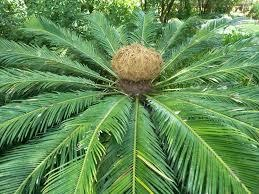
Cycas possess/show:-
A. Branched stem
B. Monoecious plant
C. Pinnately compound leaves
D. Mycorrhiza


Answer
489.6k+ views
Hint: Cycas is a gymnosperm and a part of the Cycadaceae family. They do not produce flowers, but cones, much like pine trees.
Many species of the Cycas can grow very slowly, they require patience but their maintenance is easy and needs few resources. Fertilizer is required in very little amount because they have some special type of algae living in their coralloid roots that helps in fixing the air nitrogen to the soil, so cycads make their own fertilizer from thin air.
Complete answer:
Branched stem- All gymnosperms have branched except the Cycas having unbranched stem. The stems that are unbranched are called caudex or columnar. In Cycas the caudex is cylindrical in shape surrounded by petiole bases.
Monoecious plant- Monoecious Cycas is the dioecious plant because the male and female reproductive organs are present on different trees (male and female organisms or plants).
Pinnately compound leaves- Cycas have pinnate compound leaves and persist for a few years. In a pinnate compound leaf, the leaflets are borne on an unbranched axis or rachis. The rachis represents the midrib of the lamina.
Mycorrhiza- The mycorrhiza is that type of roots occurring between higher level plants and fungus while coralloid roots help in fixing the air nitrogen. So, in Cycas the coralloid roots are found.
So, the correct answer is option (3), pinnately compound leaves.
Note:
A leaf is said to be a compound, where the lamina is completely divided into distinct segments called leaflets. The compound leaves are of two types- pinnate compound leaf and palmate compound leaf.
The Cycas plant is also known as Sago Palm. The leaves are dark green in colour and look very glossy. The trunk of Cycas plant is brown, rough and the leaves form a crown-like structure.
Many species of the Cycas can grow very slowly, they require patience but their maintenance is easy and needs few resources. Fertilizer is required in very little amount because they have some special type of algae living in their coralloid roots that helps in fixing the air nitrogen to the soil, so cycads make their own fertilizer from thin air.
Complete answer:
Branched stem- All gymnosperms have branched except the Cycas having unbranched stem. The stems that are unbranched are called caudex or columnar. In Cycas the caudex is cylindrical in shape surrounded by petiole bases.
Monoecious plant- Monoecious Cycas is the dioecious plant because the male and female reproductive organs are present on different trees (male and female organisms or plants).
Pinnately compound leaves- Cycas have pinnate compound leaves and persist for a few years. In a pinnate compound leaf, the leaflets are borne on an unbranched axis or rachis. The rachis represents the midrib of the lamina.
Mycorrhiza- The mycorrhiza is that type of roots occurring between higher level plants and fungus while coralloid roots help in fixing the air nitrogen. So, in Cycas the coralloid roots are found.
So, the correct answer is option (3), pinnately compound leaves.
Note:
A leaf is said to be a compound, where the lamina is completely divided into distinct segments called leaflets. The compound leaves are of two types- pinnate compound leaf and palmate compound leaf.
The Cycas plant is also known as Sago Palm. The leaves are dark green in colour and look very glossy. The trunk of Cycas plant is brown, rough and the leaves form a crown-like structure.
Recently Updated Pages
Master Class 11 Social Science: Engaging Questions & Answers for Success

Master Class 11 Physics: Engaging Questions & Answers for Success

Master Class 11 Maths: Engaging Questions & Answers for Success

Master Class 11 Economics: Engaging Questions & Answers for Success

Master Class 11 Computer Science: Engaging Questions & Answers for Success

Master Class 11 Chemistry: Engaging Questions & Answers for Success

Trending doubts
What is meant by exothermic and endothermic reactions class 11 chemistry CBSE

10 examples of friction in our daily life

One Metric ton is equal to kg A 10000 B 1000 C 100 class 11 physics CBSE

Difference Between Prokaryotic Cells and Eukaryotic Cells

1 Quintal is equal to a 110 kg b 10 kg c 100kg d 1000 class 11 physics CBSE

Draw a diagram of nephron and explain its structur class 11 biology CBSE




